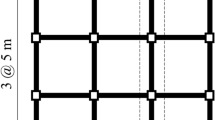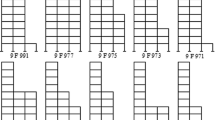Abstract
In recent years, nonlinear static procedures (NSPs) have gained considerable popularity as an efficient tool in the performance based seismic design practice. This was backed by extensive corroboration studies that have demonstrated its good accuracy in estimating the seismic response of regular structures. Despite the numerous improvements of the original versions of NSPs, their use to assess the seismic response of irregular structures and high-rise buildings is still challenging; they are not able to predict with sufficient accuracy all the complexities associated to the seismic response of this type of structures. Thus, an improved upper-bound (IUB) pushover procedure for seismic assessment of plane frames is presented in this paper, aiming to enhance the accuracy of existing methods in predicting the seismic behaviour of high-rise buildings. The novelty of this proposal is based on the adjustment of the pattern of the lateral load of the upper-bound pushover method applied to tall structures. The accuracy of the procedure is tested using nine, twelve, fifteen and twenty storeys steel buildings. The results of the (IUB) are compared to those of the capacity spectrum method, the modal pushover analysis, the upper bound pushover analysis, the modified upper bound pushover analysis and the non-linear time history analysis (NTHA). In most cases, the proposed procedure shows better results and closer to those obtained by NTHA.





















Similar content being viewed by others
References
Abbasnia R, Tajik Davoudi A (2013) An adaptive pushover procedure based on effective modal mass combination rule. Eng Struct 52:654–666
Antoniou S, Pinho R (2004a) Advantages and limitations of adaptive and non-adaptive force-based pushover procedures. J Earthq Eng 8:497–522
Antoniou S, Pinho R (2004b) Development and verification of a displacement-based adaptive pushover procedure. J Earthq Eng 8:643–661
ATC (1996) Seismic evaluation and retrofit of concrete buildings. Report ATC-40. Applied Technology Council, Redwood City (CA)
Belejo A, Bento R (2016) Improved modal pushover analysis in seismic assessment of asymmetric plan buildings under the influence of one and two horizontal components of ground motions. Soil Dyn Earthq Eng 87:1–15
Bento R, Bhatt C, Pinho R (2010) Adaptive capacity spectrum method for seismic assessment of 3D irregular SPEAR buildings. Earthq Struct 1:177–195
Bhatt C, Bento R (2014) The extended adaptive capacity spectrum method for the seismic assessment of plan-asymmetric buildings. Earthq Spectra 30:683–703
CEN (2004) ENV 1998-1 Eurocode 8: design of structures for earthquake resistance—part 1: general rules, seismic actions and rules for buildings. European Committee for Standardization, Brussels
Chopra AK (2012) Dynamics of structures: theory and applications to earthquake engineering, 4th edn. Prentice Hall, Hong Kong
Chopra A, Goel R (2002) A modal pushover analysis procedure for estimating seismic demands for buildings. Earthq Eng Struct Dyn 31:561–582
Chopra A, Goel R (2004) A modal pushover analysis procedure to estimate seismic demands for unsymmetrical-plan buildings. Earthq Eng Struct Dyn 33:903–927
Computers and Structures Inc. (CSI) (2013) SAP2000NL. Berkeley, CA, USA
Davoudi AT, Abbasnia R, Sarvghad-Moghadam A, Maddah M-M, Khodam A (2016) An alternative modal combination rule for adaptive pushover analysis. Struct Des Tall Spec Build 25:325–339
Fajfar P (1999) Capacity spectrum method based on inelastic demand spectra. Earthq Eng Struct Dyn 28:979–993
Fajfar P, Fischinger M (1988) N2—a method for non-linear seismic analysis of regular buildings. In: Proceedings of the 9th World conference in earthquake engineering, Tokyo–Kyoto, Japan, pp 111–116
Fajfar P, Marusic D, Perus I (2005) Torsional effects in the pushover-based seismic analysis of buildings. J Earthq Eng 9:831–854
FEMA (2000) Prestandard and commentary for the seismic rehabilitation of buildings. FEMA 356 Federal Emergency Management Agency, Washington (DC)
FEMA (2000) State of the art report on systems performance of steel moment frames subject to earthquake ground shaking, FEMA 355C, SAC Joint Venture and FEMA, Washington (DC)
Freeman S (1998) The capacity spectrum method as a tool for seismic design. In: Proceedings of the 11th European conference on earthquake engineering, Paris, France
Ghahari SF, Moradnejad HR, Rouhanimanesh MS, Sarvghad-Moghadam A (2013) Studying higher mode effects on the performance of nonlinear static analysis methods considering Near-Fault effects. KSCE J Civ Eng 17(2):426–437
Gupta A, Krawinkler H (1999) Seismic demands for performance evaluation of steel moment resisting frame structures. John A, Blume Earthquake Engineering Research Center, Rep. No. 132. Department of Civil Engineering, Stanford University
Gupta B, Kunnath SK (2000) Adaptive spectra-based pushover procedure for seismic evaluation of structures. Earthq Spectra 16:367–391
Jan TS, Liu MW, Kao YC (2004) An upper-bound pushover analysis procedure for estimating the seismic demands of high-rise buildings. Eng Struct 26:117–128
Kreslin M, Fajfar P (2011) The extended N2 method taking into account higher mode effects in elevation. Earthq Eng Struct Dyn 40(14):1571–1589
Kreslin M, Fajfar P (2012) The extended N2 method considering higher mode effects in both plan and elevation. Bull Earthq Eng 10:695–715
NBCC (2005) National building code of Canada. Canadian Commission on Building and Fire Codes, National Research Council of Canada, Ottawa, Canada
P100-1/2006 (2006) Seismic design code. Part 1: earthquake resistant design of buildings. Buletinul Construcţiilor, No. 12–13. INCERC, Bucharest, Romanian
Paraskeva TS, Kappos AJ (2010) Further development of a multimodal pushover analysis procedure for seismic assessment of bridges. Earthq Eng Struct Dyn 39:211–222
Poursha M, Samarin ET (2015) The modified and extended upper-bound (UB) pushover method for the multi-mode pushover analysis of unsymmetric-plan tall buildings. Soil Dyn Earthq Eng 71:114–127
Poursha M, Khoshnoudian F, Moghadam AS (2009) A consecutive modal pushover procedure for estimating the seismic demands of tall buildings. Eng Struct 31:591–599
Poursha M, Khoshnoudian F, Moghadam AS (2014) The extended consecutive modal pushover procedure for estimating the seismic demands of two-way unsymmetric-plan tall building structures under influence of two horizontal components of ground motions. Soil Dyn Earthq Eng 63:162–173
Reyes JC, Chopra AK (2011) Three-dimensional modal pushover analysis of buildings subjected to two components of ground motion, including its evaluation for tall buildings. Earthq Eng Struct Dyn 40:789–806
Shakeri K, Shayanfar MA, Kabeyasawa T (2010) A story shear-based adaptive pushover procedure for estimating seismic demands of buildings. Eng Struct 32:174–183
Standard No. 2800-05 (2005) Iranian code of practice for seismic resistant design of buildings, 3rd edn. Building and Housing Research Centre, Iran
Tarta G, Pintea A (2012) Seismic evaluation of multi-storey moment-resisting steel frames with stiffness irregularities using standard and advanced pushover methods. Procedia Eng 40:445–450
UBC (1994) Uniform building code. International Conference of Building Officials, Whittier, CA
Yousuf M, Bagchi A (2009) Seismic performance of a 20-story steel-frame building in Canada. Struct Des Tall Spec Build 19:901–921
Acknowledgements
The financial support of the Ministry of higher education MESRS in Algeria (Grant CNEPRU J0400420140007) for conducting this study is greatly acknowledged.
Author information
Authors and Affiliations
Corresponding author
Rights and permissions
About this article
Cite this article
Rahmani, A.Y., Bourahla, N., Bento, R. et al. An improved upper-bound pushover procedure for seismic assessment of high-rise moment resisting steel frames. Bull Earthquake Eng 16, 315–339 (2018). https://doi.org/10.1007/s10518-017-0204-9
Received:
Accepted:
Published:
Issue Date:
DOI: https://doi.org/10.1007/s10518-017-0204-9




